The beautiful documentary “Cosmic Voyage“, is currently available for free on Hulu. It’s one of those things that sparks the imagination. UPDATE: At least it was on Hulu for a while. If I find it somewhere else I’ll post the link here.
Category: Natural World
Waves and interference
There are lots of interesting interactive wave demonstrations on the web. The particularly interesting ones are the ones that show interference. Some of them make your eyes water. Others make your ears hurt. These simple animations show superposition (constructive and destructive interference) very nicely, but the language is a little advanced.
What I like about Dan Russell’s 2d animations is that they show the wave motion using particles. If you track a single particle with your eye you can see that while the wave moves from one side of the area to the other, the particles just move back and forth in the same general region.

I like this demo because you easily control the wave amplitude and lengths of two waves and it shows how they superimpose.
This animation of wave interference is nice because when you click on the 2d animation it shows the two waves’ effects at the point you’ve chosen as curves. You can choose points to show both constructive and destructive interference.
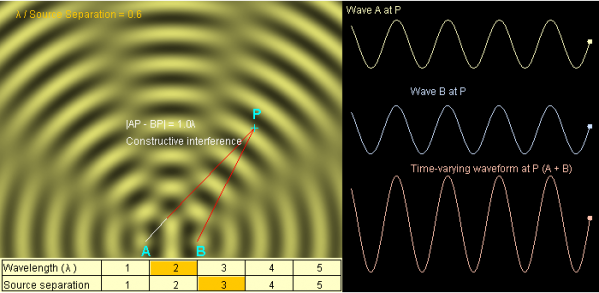

This elegant but somewhat complex video shows the two dimensional sine waves generated by a rotating wheel.

Seeing temperature, kinetic energy and color
We read that temperature is the average kinetic energy of a substance but you can (especially if you’re a visual learner) nicely internalize this from simple videos or animations. UCAR has a little animation with their definition of temperature. I however, adapted an interactive, 3d animation that I think does a nice job, and also introduces a couple of other interesting concepts too.
I’ve also used this model, at different times, to show:
- The relationship between temperature and color emitted by objects. The main way we know the temperature of stars is because blue stars are hotter than red stars. Blue light has a shorter wavelength than red light, and things that are at higher temperatures emit shorter wavelengths.
- Absolute zero (0 Kelvin) – where (almost) all motion stops and the objects stop emitting light.
- Pressure in a gas – you really get a feel for the force exerted by the particles on the side of the box (although it might be even more interesting once I figure out how to add sound).
It is an interactive model, but it’s pretty simple because the only control is a slider that lets you set the temperature.
Finally, in the age of 3d movies, like Avatar, the models can be easily shown in 3d if you have the glasses (redcyan).
The model is easy to install and run on Windows, but you have to install the programming language VPython separately on a Mac (but that isn’t very hard). I have this, and a bunch of other models, at http://earthsciweb.org/GeoMod/.
Best science fiction? (without John Wyndham and The Chrysalids?)
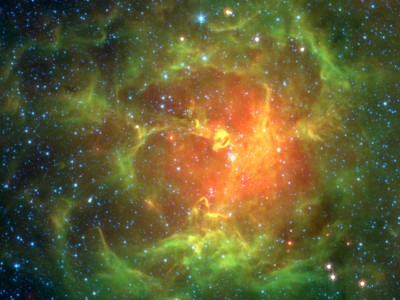
I discovered science fiction in my early teens but it was always hard to find the great stories in the midst of a lot of drivel. This list of 100 good science fiction and fantasy books seems to be a good start. Most of the books on the list are worthy, but it completely misses John Wyndham (The Chrysalids among others) and Brian Stableford (e.g. War Games). There are also a few that bored me to tears (Bradley’s Avalon) and some that I did not think were very well written (Crichton’s Sphere).
I like science fiction because it tends to deal with some of the big issues that adolescents are facing. Who am I, what’s the future going to be like, what does it mean to be human, what’s my place in society, and of course, wouldn’t it be nice it everyone just disappeared and I had the world all to myself? You also get to tie it in to the Natural World and Social World curriculum.
The Chrysalids is a great example. A post-apocalyptic novel, it looks at, among other things, institutional discrimination, the conflict between science and religion, and evolutionary theory (with it’s darker side eugenics). Wyndham addresses these issues with interesting characters and wonderful, intelligent storytelling (with a heroic journey). I’ve used this book as part of the life sciences curriculum for the tie-in to evolution, and to the history of the Cold War. But I also bring it up when we discuss human rights and discrimination.
Voyager

The Voyager spacecraft, launched in 1977, are still going and making new discoveries. They are after all the man-made objects that are furthest away from the center of the solar system, beyond the orbit of Pluto, and are now approaching interstellar space.
Where does the solar system end and interstellar space begin? Well, the Sun gives off light, but it also emits a plasma of charged particles (protons and electrons typically) that’s called the solar wind. These charged particles are launched from the Sun pretty fast, but as they get to the edge of the solar system they start to slow down, because the solar system is moving through a magnetic cloud, and, as we all know, charged particles are affected by magnetic fields.
The solar wind, assisted by the Sun’s magnetic field, pushes against the interstellar magnetic cloud, creating a bubble, called the heliosphere (helio=sun, sphere=sphere) that is pretty much the edge of the solar system.
Both Voyager spacecraft are approaching the heliosphere, and we’ve recently discovered that as the solar system moves through the interstellar magnetic cloud, the heliosphere is pushing against the cloud and the cloud is pushing back quite a bit. As a result, the heliosphere is shaped like the bow wave of water around a speeding boat.
It is difficult not to personify these two lonely spacecraft as the get further and further away from home, with no way to get back, but sending signals that tell of their discoveries and ensure their immortality.
The Galilean moons of Jupiter
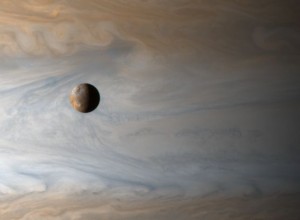
400 years ago, on January 7th, Galileo Galilei made his first observations of Jupiter. You can see his notes below. The big circle is Jupiter and the small dots are the specks of light he observed adjacent to the planet. Later observations showed that the specks did not stay in the same place, and lead him to realize that he was seeing moons orbiting the planet.
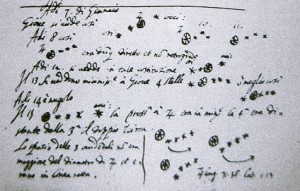
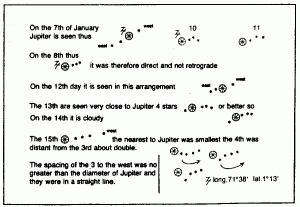
Galileo used a 33x telescope, which is pretty weak by modern standards, in fact you should be able to see Jupiter and it’s moons with a good pair of binoculars. Since the Catholic church at the time preferred the view that the Earth was the center of the universe, when Galileo published his observation he got into a bit of trouble. In his publication Galileo wrote:
On the 7th day of January in the present year, 1610, in the first hour of the following night, when I was viewing the constellations of the heavons through a telescope, the planet Jupiter presented itself to my view, and as I had prepared for myself a very excellent instrument, I noticed a circumstance which I had never been able to notice before, namely that three little stars, small but very bright, were near the planet; and although I believed them to belong to a number of the fixed stars, yet they made me somewhat wonder, because they seemed to be arranged exactly in a straight line, parallel to the ecliptic, and to be brighter than the rest of the stars, equal to them in magnitude . . .When on January 8th, led by some fatality, I turned again to look at the same part of the heavens, I found a very different state of things, for there were three little stars all west of Jupiter, and nearer together than on the previous night.
The above quote comes NASA’s page on the discovery of the Galilean satellites (for a full translation of the entire document go to: The Starry Messenger). The NASA page also has another neat quote, from Simon Marius describing how the moons got their names:
Jupiter is much blamed by the poets on account of his irregular loves. Three maidens are especially mentioned as having been clandestinely courted by Jupiter with success. Io, daughter of the River, Inachus, Callisto of Lycaon, Europa of Agenor. Then there was Ganymede, the handsome son of King Tros, whom Jupiter, having taken the form of an eagle, transported to heaven on his back …
For perspective, the image below, of Io’s surface, was taken by NASA’s Galileo spacecraft. Click on the image to get to the high resolution version.

The Galileo Mission website is a great resource about the mission to Jupiter and about Galileo Galilei himself. You can also find out what NASA’s up to with respect to Jupiter here.
Evil, mad, scientist!
Why have I not found this site before, Evil Mad Scientist Laboratories. A place where people will put serious thought, rigorous design and atrocious single-mindedness to create, well I’m not sure I can call it anything other than, “very interesting” projects. Applications of robotics that would make Asimov cry (probably with joy at human ingenuity, probably).
They carefully detail how to create such wonderful projects as:
And many more interesting and eclectic projects for an interesting middle school.
Geometry and the height of the mountains on the moon

Galileo Galilei matched careful observation of sunlight and shadows on the moon, with some beautiful geometry to estimate the height of lunar mountains, in 1609. He needed the Pythagoras’ Theorem and the quadratic formula, both of which middle school students should be familiar. Larry Phillips has a nice post describing how Galileo did the math. The image below (from Pioneers of Science shows how to get started.


